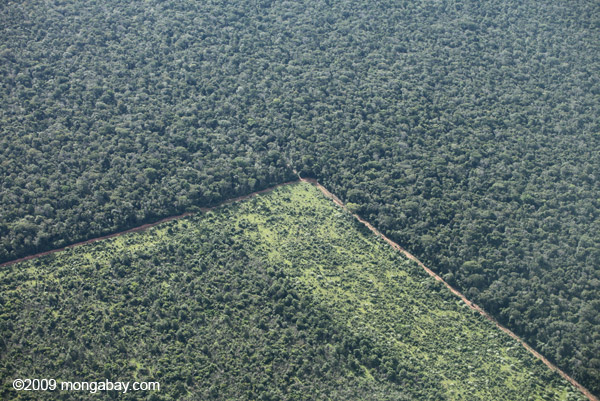Rainforests that have been affected by even low-intensity fires are far more vulnerable to invasion by grasses, finds a new study published in special issue of the journal Philosophical Transactions of the Royal Society B. The findings are significant because they suggest that burned forests may be more susceptible to subsequent fires which may burn more intensely due to increased fuel loads.
The research is based on an eight-year study involving experimental burning of three 50-hectare plots in the Amazon rainforest. Each plots underwent a different “fire treatments” — no burning, burning every year, and burning every three years. While the fires were small, their impact was significant. Both types of burned plots experienced invasion of native and non-native grasses from adjacent pasture lands. The plot that was burned on a three-year cycle, actually had the highest total area invaded by grasses (10 percent of its area).
The areas that had the highest fuel loads were those dominated by exotic grasses often used to seed cattle pasture. Naturally, areas with higher fuel loads are at risk for more intense and more damaging fires.
The study however found that grass invasion was generally limited to forest edge areas, a result the authors attribute to difficulties in seed dispersal, herbivory, and lower light availability in deeper forest zones. Nonetheless, the researchers said the findings support the argument that parts of the Amazon rainforest may become increasingly susceptible to transitioning toward a drier, grassier ecosystem if forest fragmentation and recent incidents of severe drought continue.
“Major increases in grass invasion occurred following intense fires associated with drought events,” the authors write. “This result suggests that fire could mediate the predicted climate-driven substitution of large portions of Amazonian forest by grass-dominated ecosystems. With the increases in air temperatures and decreases in precipitation predicted for the Amazon, fires are expected to become more frequent and intense, killing proportionally more trees.”
“Although seed dispersal may limit invasion into fire-disturbed forests, seeds of exotic grasses are already abundant, particularly in the Xingu Basin where pastures cover much of the landscape. While seeds of exotic C4 grasses are abundant only along forest edges, approximately 16 per cent of Xingu Basin forests are less than 200 from a forest-pasture edge.”

Forest edge in Mato Grosso, the Southern Amazon.
The Amazon rainforest is the world’s single largest terrestrial carbon sink. Any large-scale degradation of the ecosystem’s capacity to store carbon could have long-term implications for global climate.
CITATION: Silverio DV, Brando PM, Balch JK, Putz FE, Nepstad DC, Oliveira-Santos C, Bustamante MMC. 2013 Testing the Amazon savannization hypothesis: fire effects on invasion of a neotropical forest by native cerrado and exotic pasture grasses. Phil Trans R Soc B 368: 20120427. http://dx.doi.org/10.1098/rstb.2012.0427